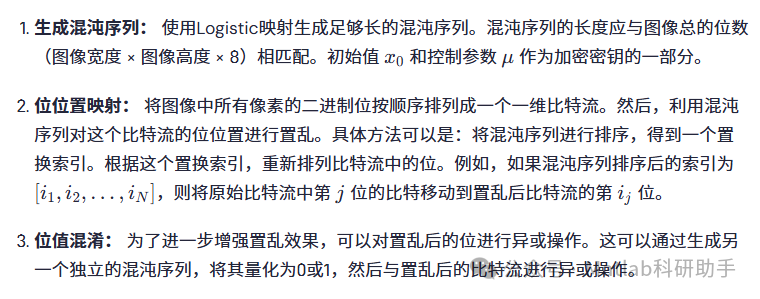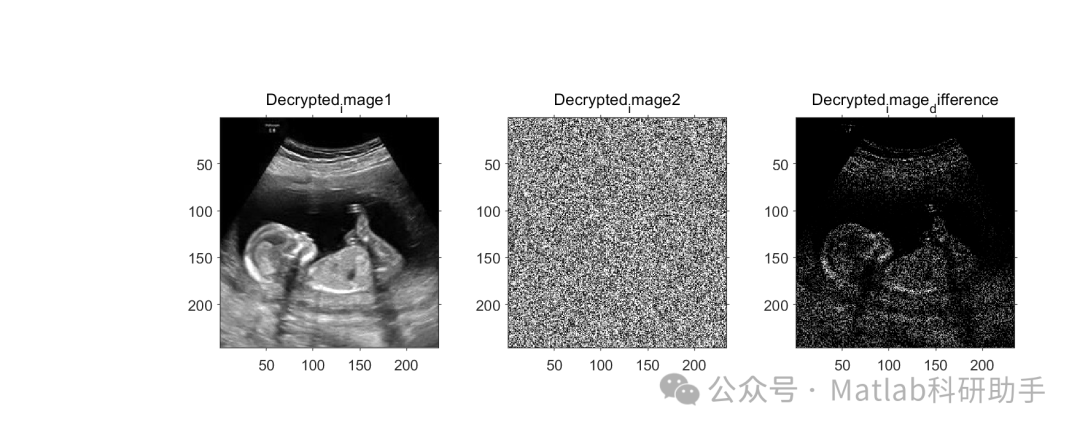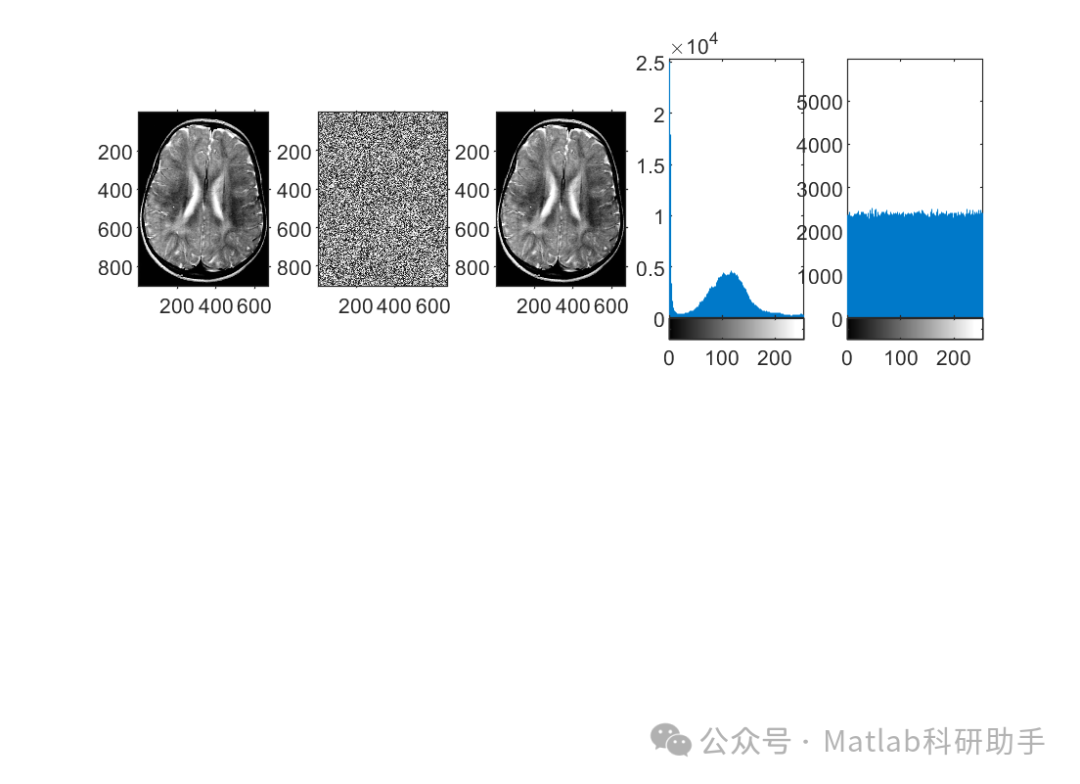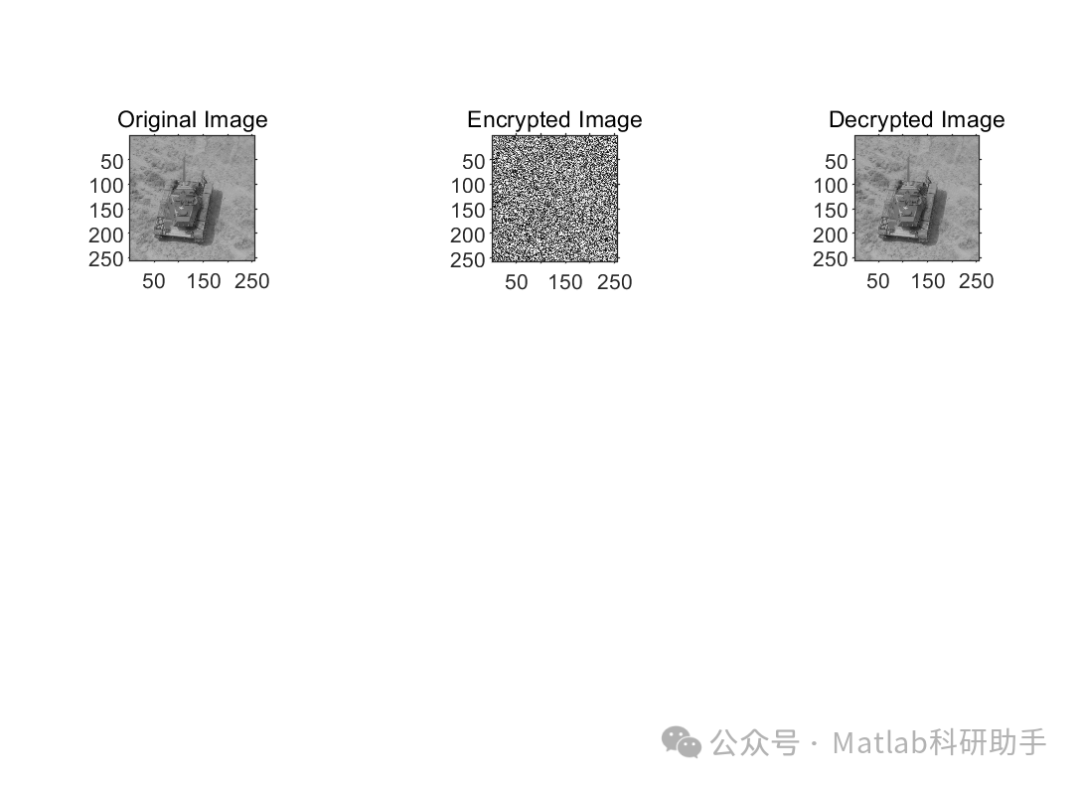✅ Author’s Profile: A research enthusiast and Matlab simulation developer, skilled in data processing, modeling simulation, program design, complete code acquisition, paper reproduction, and scientific simulation.
🍎 Previous Review: Follow my personal homepage:Matlab Research Studio
🍊 Personal Motto: Investigate to gain knowledge, complete Matlab code and simulation consultation available via private message.
🔥 Content Introduction
With the widespread application of digital images in information transmission and storage, the secure transmission of image information has become increasingly important. Traditional encryption algorithms often exhibit inefficiency when processing image data and fail to adequately utilize the unique properties of images. This paper addresses these issues by proposing a novel bit-level image encryption algorithm based on chaotic mapping. The algorithm utilizes the sensitivity of chaotic systems to initial conditions and their pseudo-randomness to scramble and diffuse the pixel bits of images, thereby achieving effective image encryption. Experimental results indicate that this algorithm demonstrates good encryption effectiveness, high security, and robustness against noise, providing a new approach and method for the field of image encryption.
Keywords: Image encryption; chaotic mapping; bit-level scrambling; information security; digital image processing
1. Introduction
In today’s era of information explosion, digital images, as important carriers of information, are widely used in various fields such as medical, military, communication, and e-commerce. However, the openness, redundancy, and insecurity of image information during transmission make image encryption a critical issue that needs to be addressed. Traditional encryption algorithms, such as Data Encryption Standard (DES) and Advanced Encryption Standard (AES), are primarily designed for text data, and their encryption speed and efficiency are often unsatisfactory when handling massive image data. Additionally, the inherent high correlation and high redundancy of image data expose some shortcomings of traditional encryption algorithms in the field of image encryption.
In recent years, chaos theory, with its sensitivity to initial conditions, pseudo-randomness, ergodicity, and ability to describe non-periodic motion, has provided a new research direction for image encryption. The chaotic sequences generated by chaotic systems possess noise-like characteristics, effectively disrupting the correlation between image pixels, thereby enhancing the security of encryption algorithms. Currently, chaotic-based image encryption algorithms have become a research hotspot and have made significant progress. However, most existing chaotic image encryption algorithms mainly focus on pixel-level scrambling and diffusion, with less attention paid to bit-level operations. Bit-level operations can more finely alter the pixel values of images, further enhancing the strength and robustness of encryption.
This paper aims to propose a novel bit-level image encryption algorithm based on chaotic mapping. The algorithm fully utilizes the complexity and unpredictability of chaotic mapping to achieve effective image encryption through the scrambling and diffusion of pixel bits. This paper will detail the design principles, implementation steps of the algorithm, and validate its performance and security through experiments.
2. Theoretical Foundation of Chaotic Mapping
Chaos refers to a universal phenomenon occurring in deterministic nonlinear dynamical systems, characterized by extreme sensitivity to initial conditions, where small initial disturbances can lead to significant differences in system states. At the same time, chaotic systems exhibit inherent randomness, with trajectories in phase space showing non-repetitive and irregular characteristics, yet confined within a bounded region known as a chaotic attractor.
Common chaotic mappings include Logistic mapping, Lorenz system, Chen system, etc. This paper mainly considers using one-dimensional Logistic mapping as the generator of chaotic sequences, expressed mathematically as follows:

3. Design of the Novel Bit-Level Image Encryption Algorithm
The design concept of this algorithm is to fully utilize the characteristics of chaotic mapping to achieve effective image encryption through the scrambling and diffusion of bit-level data. The algorithm mainly includes the following stages: image preprocessing, bit-level scrambling, bit-level diffusion, and key generation and management.
3.1 Image Preprocessing
The input image is typically an RGB color image or a grayscale image. For color images, it needs to be decomposed into independent R, G, and B components for processing. For grayscale images, the pixel values are processed directly. Each pixel value (0-255) of the image is converted into an 8-bit binary sequence. For example, a pixel value of 100 is represented in binary as 01100100.
3.2 Bit-Level Scrambling
Bit-level scrambling is a key step in the encryption process, aimed at breaking the spatial correlation between image pixels. This algorithm employs a bit-level scrambling method based on chaotic sequences.

3.3 Bit-Level Diffusion
The purpose of bit-level diffusion is to ensure that small changes in the original image can cause significant changes in the encrypted image, thereby resisting differential attacks. This algorithm adopts a chain diffusion mechanism based on chaotic sequences.
-
Generate Diffusion Chaotic Sequence: A new chaotic sequence is generated using chaotic mapping, with initial values and control parameters that may differ from those in the scrambling phase to increase the key space.
-
Chain XOR Diffusion: The bit stream after bit-level scrambling undergoes a chain XOR operation again. Specifically, an initial diffusion value (for example, derived from a value of the chaotic sequence) is set, and each bit in the bit stream is XORed with the encryption result of the previous bit and the corresponding bit in the diffusion chaotic sequence.

3.4 Key Generation and Management
The keys of this algorithm mainly include:

These key parameters need to have high precision to ensure the sensitivity of the chaotic system. The length and randomness of the keys directly affect the security of the algorithm. It is recommended to use sufficiently long keys and to transmit and store them through a secure key management mechanism.
5. Conclusion
This paper proposes a novel bit-level image encryption algorithm based on chaotic mapping. The algorithm fully utilizes the sensitivity of chaotic systems to initial conditions and their pseudo-randomness to effectively achieve image encryption through the scrambling and diffusion of pixel bits. Experimental results indicate that this algorithm has the following advantages:
- Good Encryption Effect: The encrypted image appears as complete random noise, making it impossible to discern the original image information.
- High Security: It can effectively resist statistical analysis attacks and differential attacks, with low correlation between adjacent pixels and high information entropy.
- Large Key Space: The key parameters are floating-point numbers, and by controlling precision, a sufficiently large key space can be achieved to resist exhaustive attacks.
- Robustness to Noise: Bit-level operations provide the algorithm with a certain robustness against minor noise in the image.
This algorithm provides a new approach and method for the field of image encryption, especially suitable for scenarios requiring high security for image transmission and storage. Future research directions may include exploring more complex chaotic systems or combinations of multiple chaotic systems to further enhance the complexity and security of the algorithm; studying the performance of the algorithm across different image formats and application scenarios; and developing more efficient hardware implementation solutions to meet the demands of real-time image encryption.
⛳️ Operation Results






🔗 References
[1] Fan Chunxia, Jiang Changsheng. A Chaotic Mapping-Based Image Encryption Algorithm [J]. Optical Precision Engineering, 2004, 12(2). DOI:10.3321/j.issn:1004-924X.2004.02.011.
[2] Fan Chunxia, Jiang Changsheng. A Chaotic Mapping-Based Image Encryption Algorithm [J]. Optical Precision Engineering, 2004. DOI:JournalArticle/5af1c220c095d718d8ec2c84.
[3] Wang Di, Deng Jiaxian, Deng Haitao. A New Image Encryption Algorithm Based on Discrete Chaotic Systems and SHA-1 [J]. Computer Applications Research, 2014, 31(10):4. DOI:10.3969/j.issn.1001-3695.2014.10.054.
📣 Partial Code
🎈 Some theoretical references are from online literature; please contact the author for removal if there is any infringement.
👇 Follow me to receive a wealth of Matlab e-books and mathematical modeling materials
🏆 Our team specializes in guiding customized Matlab simulations in various research fields, helping to realize research dreams:
🌈 Various intelligent optimization algorithm improvements and applications
Production scheduling, economic scheduling, assembly line scheduling, charging optimization, workshop scheduling, departure optimization, reservoir scheduling, three-dimensional packing, logistics site selection, cargo location optimization, bus scheduling optimization, charging pile layout optimization, workshop layout optimization, container ship loading optimization, pump combination optimization, medical resource allocation optimization, facility layout optimization, visual domain base station and drone site selection optimization, knapsack problem, wind farm layout, time slot allocation optimization, optimal distributed generation unit allocation, multi-stage pipeline maintenance, factory-center-demand point three-level site selection problem, emergency life material distribution center site selection, base station site selection, road lamp post arrangement, hub node deployment, transmission line typhoon monitoring devices, container scheduling, unit optimization, investment optimization portfolio, cloud server combination optimization, antenna linear array distribution optimization, CVRP problem, VRPPD problem, multi-center VRP problem, multi-layer network VRP problem, multi-center multi-vehicle VRP problem, dynamic VRP problem, two-layer vehicle routing planning (2E-VRP), electric vehicle routing planning (EVRP), oil-electric hybrid vehicle routing planning, hybrid flow shop problem, order splitting scheduling problem, bus scheduling optimization problem, flight shuttle vehicle scheduling problem, site selection path planning problem, port scheduling, port bridge scheduling, parking space allocation, airport flight scheduling, leak source location
🌈 Machine learning and deep learning time series, regression, classification, clustering, and dimensionality reduction
2.1 BP time series, regression prediction, and classification
2.2 ENS voice neural network time series, regression prediction, and classification
2.3 SVM/CNN-SVM/LSSVM/RVM support vector machine series time series, regression prediction, and classification
2.4 CNN|TCN|GCN convolutional neural network series time series, regression prediction, and classification
2.5 ELM/KELM/RELM/DELM extreme learning machine series time series, regression prediction, and classification
2.6 GRU/Bi-GRU/CNN-GRU/CNN-BiGRU gated neural network time series, regression prediction, and classification
2.7 Elman recurrent neural network time series, regression prediction, and classification
2.8 LSTM/BiLSTM/CNN-LSTM/CNN-BiLSTM long short-term memory neural network series time series, regression prediction, and classification
2.9 RBF radial basis neural network time series, regression prediction, and classification
2.10 DBN deep belief network time series, regression prediction, and classification
2.11 FNN fuzzy neural network time series, regression prediction
2.12 RF random forest time series, regression prediction, and classification
2.13 BLS broad learning system time series, regression prediction, and classification
2.14 PNN pulse neural network classification
2.15 Fuzzy wavelet neural network prediction and classification
2.16 Time series, regression prediction, and classification
2.17 Time series, regression prediction, and classification
2.18 XGBOOST ensemble learning time series, regression prediction, and classification
2.19 Transform various combinations of time series, regression prediction, and classification
Covering wind power prediction, photovoltaic prediction, battery life prediction, radiation source identification, traffic flow prediction, load prediction, stock price prediction, PM2.5 concentration prediction, battery health status prediction, electricity consumption prediction, water body optical parameter inversion, NLOS signal identification, subway parking precision prediction, transformer fault diagnosis
🌈 In the field of image processing
Image recognition, image segmentation, image detection, image hiding, image registration, image stitching, image fusion, image enhancement, image compressed sensing
🌈 In the field of path planning
Traveling salesman problem (TSP), vehicle routing problem (VRP, MVRP, CVRP, VRPTW, etc.), drone three-dimensional path planning, drone collaboration, drone formation, robot path planning, grid map path planning, multimodal transport problems, electric vehicle routing planning (EVRP), two-layer vehicle routing planning (2E-VRP), oil-electric hybrid vehicle routing planning, ship trajectory planning, full path planning, warehouse patrol
🌈 In the field of drone applications
Drone path planning, drone control, drone formation, drone collaboration, drone task allocation, drone secure communication trajectory online optimization, vehicle collaborative drone path planning
🌈 In the field of communication
Sensor deployment optimization, communication protocol optimization, routing optimization, target location optimization, Dv-Hop location optimization, Leach protocol optimization, WSN coverage optimization, multicast optimization, RSSI location optimization, underwater communication, communication upload and download allocation
🌈 In the field of signal processing
Signal recognition, signal encryption, signal denoising, signal enhancement, radar signal processing, signal watermark embedding and extraction, electromyography signals, electroencephalography signals, signal timing optimization, electrocardiogram signals, DOA estimation, encoding and decoding, variational mode decomposition, pipeline leakage, filters, digital signal processing + transmission + analysis + denoising, digital signal modulation, bit error rate, signal estimation, DTMF, signal detection
🌈 In the field of power systems
Microgrid optimization, reactive power optimization, distribution network reconstruction, energy storage configuration, orderly charging, MPPT optimization, household electricity
🌈 In the field of cellular automata
Traffic flow, crowd evacuation, virus spread, crystal growth, metal corrosion
🌈 In the field of radar
Kalman filter tracking, trajectory association, trajectory fusion, SOC estimation, array optimization, NLOS identification
🌈 In workshop scheduling
Zero-wait flow shop scheduling problem NWFSP, permutation flow shop scheduling problem PFSP, hybrid flow shop scheduling problem HFSP, zero-idle flow shop scheduling problem NIFSP, distributed permutation flow shop scheduling problem DPFSP, blocking flow shop scheduling problem BFSP
👇